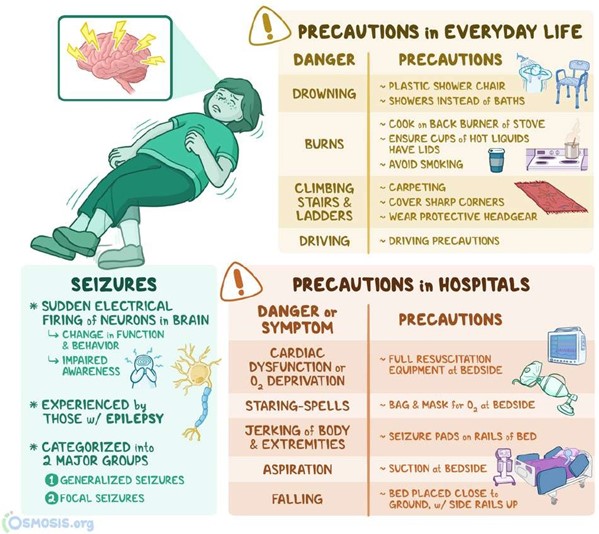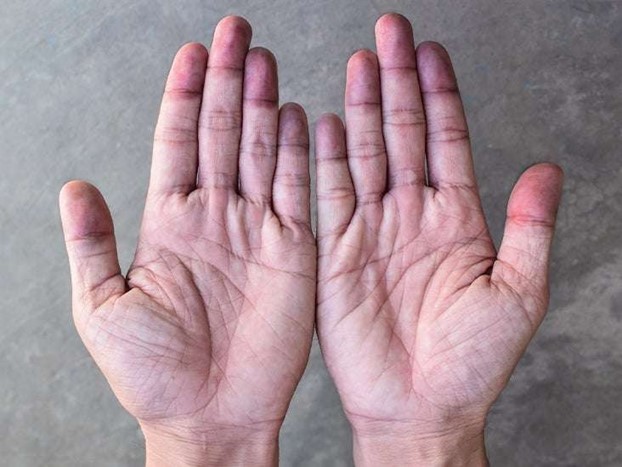A nurse is caring for an adolescent who has hyperthermia. Which of the following actions should the nurse take?
Cover the adolescent with a thermal blanket.
Submerge the adolescent’s feet in ice water.
Initiate seizure precautions.
Administer oral acetaminophen.
The Correct Answer is C

Hyperthermia is a condition in which the body temperature is abnormally high, usually due to exposure to heat, infection, or certain medications. Hyperthermia can cause neurological complications, such as seizures, confusion, or coma. Therefore, the nurse should initiate seizure precautions for an adolescent who has hyperthermia to prevent injury and protect the airway.
Choice A is wrong because covering the adolescent with a thermal blanket would increase the body temperature and worsen hyperthermia. The nurse should remove excess clothing and use cooling measures, such as fans, ice packs, or cool fluids.
Choice B is wrong because submerging the adolescent’s feet in ice water would cause vasoconstriction and shivering, which would reduce heat loss and increase heat production. The nurse should avoid using extreme cold or ice water to cool the body.
Choice D is wrong because administering oral acetaminophen would not be effective for hyperthermia caused by non-infectious factors, such as heat exposure or medications.
Acetaminophen lowers the body temperature by reducing the hypothalamic set point, which is not altered in hyperthermia. Additionally, oral medications may be difficult to swallow or absorb in a hyperthermic patient.
Normal body temperature ranges from 36.5°C to 37.5°C (97.7°F to 99.5°F). Hyperthermia is defined as a body temperature above 38.5°C (101.3°F).
Nursing Test Bank
Naxlex Comprehensive Predictor Exams
Related Questions
Correct Answer is D
Explanation

Cyanosis is a bluish discoloration of the skin and mucous membranes due to inadequate oxygenation of the blood. It is more difficult to detect in people who have dark skin, so the nurse should look for cyanosis in areas where the skin is thinner and the blood supply is richer, such as the palms of the hands, the lips, the gums, and around the eyes.
These areas are less affected by melanin, the pigment that gives skin its color.
Choice A is wrong because an area of trauma may have bruising or inflammation that can mask cyanosis.
Choice B is wrong because the sacrum is not a good site to assess for cyanosis in any skin tone, as it is prone to pressure ulcers and poor circulation.
Choice C is wrong because the shoulders are not a mucous membrane and may have more melanin than other areas of the body.
Correct Answer is C
Explanation
Having interdisciplinary team meetings for the client on a regular basis.
This action best promotes communication among staff caring for the client because it allows for consistent and coordinated care planning, information sharing, and goal setting for the client who has expressive aphasia and right hemiparesis following a stroke.
Choice A is wrong because posting swallowing precautions at the head of the client’s bed does not promote communication among staff, but rather informs them of the client’s risk of aspiration due to dysphagia, which is a common complication of stroke.
Choice B is wrong because noting changes in the treatment plan in the client’s medical record is a standard practice that does not necessarily enhance communication among staff, but rather documents the client’s progress and interventions.
Choice D is wrong because recording the client’s progress in the nurses’ notes is also a standard practice that does not necessarily enhance communication among staff, but rather provides a summary of the client’s status and care.
Expressive aphasia is an acquired language disorder that affects the ability to produce spoken or written language, while right hemiparesis is a weakness or partial paralysis of the right side of the body.
Both of these conditions are caused by damage to the left hemisphere of the brain, which is responsible for language and motor control of the right side of the body. Stroke and traumatic brain injury are common causes of left hemisphere damage
Whether you are a student looking to ace your exams or a practicing nurse seeking to enhance your expertise , our nursing education contents will empower you with the confidence and competence to make a difference in the lives of patients and become a respected leader in the healthcare field.
Visit Naxlex, invest in your future and unlock endless possibilities with our unparalleled nursing education contents today
Report Wrong Answer on the Current Question
Do you disagree with the answer? If yes, what is your expected answer? Explain.
Kindly be descriptive with the issue you are facing.
